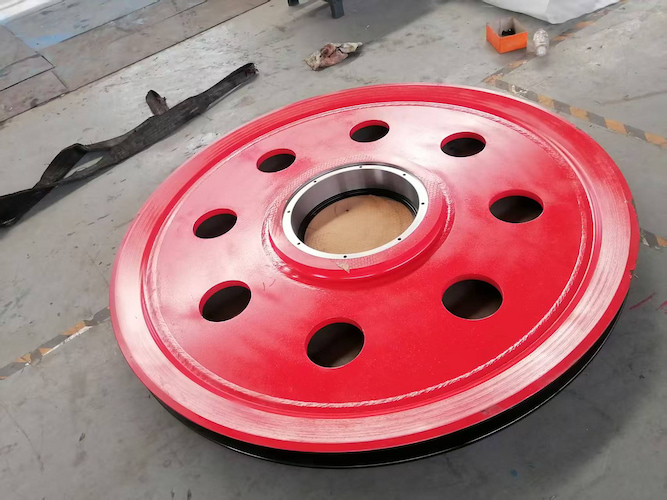Where are hoisting sheaves applied?
Mar 28, 2025
The hoisting sheaves are an important part of the hoisting system of oil drilling rigs. The sheaves of crown block and traveling block jointly form a sheave block, which is connected to the drawworks through wire ropes. By utilizing the principles of the sheave block to save force and change the direction of the force, the hoisting and lowering of the drilling tools are achieved to meet the needs of oil drilling operations. The following is the relevant introduction:
Ⅰ. Structure and Principle
Structure: The hoisting sheave is usually composed of parts such as the sheave body, bearings, sheave shaft, and rope groove. The sheave body is generally made of high-strength alloy steel or cast steel to withstand huge loads. The bearings are installed on the shaft to enable the sheave to rotate flexibly. The rope groove is used to accommodate the wire rope, and its shape and size are matched with the wire rope to ensure that the wire rope will not jump out of the groove during operation.
Principle: The sheaves of the crown block and the traveling block form a sheave block, which is connected to the drawworks through wire ropes. When hoisting, the drum of the drawworks winds the wire rope, and through the action of the sheave block, the drilling rig hook and the drilling tools are lifted. When lowering, the drilling tools descend under their own weight, and the lowering speed of the hook is controlled by the braking mechanism and auxiliary brakes of the drawworks.
Ⅱ. Functions
Saving Force: Through the combination of the sheave block, the amplification of force can be achieved, enabling the drawworks to hoist or lower heavier drilling tools with less force, reducing the requirements for the power and driving force of the drawworks.
Changing the Direction of Force: It changes the pulling force direction of the wire rope from the horizontal direction of the drawworks to the vertical direction, adapting to the hoisting and lowering requirements of the drilling tools, and can transmit the force to the required position.
Improving Hoisting Efficiency: The coordinated operation of multiple sheaves increases the number of winding turns of the wire rope, reduces the wear of the wire rope, and also improves the stability and reliability of the hoisting system, thus improving the efficiency of drilling operations.
Ⅲ. Crown Block Sheaves
Location and Function: Installed at the top of the derrick, it is a set of fixed sheaves and is the highest point of the entire hoisting system. Its main function is to change the direction of the wire rope and transmit the pulling force of the drawworks to the traveling block and the drilling tools to achieve the hoisting and lowering of the drilling tools. There are usually a large number of crown block sheaves, and the number and size of the sheaves vary according to the model of the drilling rig and the hoisting capacity.
Structural Features: The crown block sheaves are usually composed of multiple sheaves, which are installed on a common frame or wheel shaft. The number of sheaves is determined according to the drilling depth, hoisting weight, and system design requirements. Common configurations include 3 wheels, 4 wheels, 5 wheels, etc. The sheaves are generally made of high-strength alloy steel to withstand huge pulling forces and wear. Their surfaces are specially treated, such as quenching and chrome plating, to improve hardness and wear resistance and reduce the wear of the wire rope. The bearings of the sheaves are high-performance rolling bearings, which can withstand large radial and axial loads, ensure the flexible rotation of the sheaves, and reduce the frictional resistance.
Working Principle: When the drawworks pulls the crown block sheave through the wire rope, the sheave rotates around the shaft. Due to its fixed position at the top of the derrick, the direction of the wire rope is changed, allowing the wire rope to be vertically connected to the traveling block downward, converting the horizontal pulling force of the drawworks into the vertical pulling force for hoisting the drilling tools.
Ⅳ. Traveling Block Sheaves
Location and Function: The traveling block sheaves are located below the crown block, and they are movable sheaves. They are connected to the crown block through wire ropes and are also connected to the hook, which in turn suspends the drilling tools. The function of the traveling block sheaves is to cooperate with the crown block sheaves to jointly complete the hoisting, lowering, and suspension operations of the drilling tools. At the same time, during the hoisting process, they share the pulling force of the wire rope, reducing the load borne by a single sheave.
Structural Features: The structure of the traveling block sheaves is similar to that of the crown block sheaves, and they are also a sheave block composed of multiple sheaves. The material, manufacturing process, and surface treatment method of its sheaves are basically the same as those of the crown block sheaves to meet the same strength and wear resistance requirements. The frame structure design of the traveling block needs to consider the connection with the hook and the overall stability to ensure smooth operation during the hoisting and lowering of the drilling tools and reduce shaking and swinging.
Working Principle: In the drilling operation, the wire rope passes around the crown block sheave and the traveling block sheave to form a closed system. When the drawworks pulls the wire rope, the crown block sheave and the traveling block sheave rotate simultaneously. Since the traveling block can move up and down along the derrick guide rails, it can drive the hook and the drilling tools to move in the vertical direction. During the hoisting process, multiple rope strands are formed between the crown block and the traveling block sheaves, and each rope strand shares a part of the weight of the drilling tools, thus reducing the pulling force borne by each sheave and improving the safety and reliability of the entire hoisting system.
Ⅴ. To select suitable crown block and traveling block sheaves for specific oil drilling operations, the following multiple factors need to be comprehensively considered:
Drilling Depth: The drilling depth directly affects the required hoisting force and the length of the wire rope. Generally speaking, the greater the depth, the greater the required hoisting force, and sheaves with higher bearing capacity should be selected. At the same time, the size of the sheave may also need to be larger to accommodate a longer wire rope. For example, for ultra-deep well drilling, large-diameter and high-strength sheaves may be required to meet the hoisting requirements.
Hoisting Weight: Accurately calculate the maximum hoisting weight including the drilling tools, casing pipes, drilling fluid, etc. Select sheaves that can bear the corresponding load according to this weight. Usually, the rated load of the sheave should be 1.2 to 1.5 times greater than the maximum hoisting weight to ensure a safety margin. For example, if the maximum hoisting weight is 200 tons, the rated load of the sheave should be between 240 and 300 tons.
Wire Rope Specifications: Different specifications of wire ropes need to be matched with sheaves of corresponding sizes and groove shapes. The diameter of the rope groove of the sheave should be suitable for the diameter of the wire rope. Generally, the diameter of the rope groove is 1 to 2 mm larger than the diameter of the wire rope to ensure that the wire rope can be well embedded in the rope groove and reduce wear and sliding. At the same time, the rope capacity of the sheave should also meet the length requirements of the wire rope in the drilling operation.
Working Environment: If the drilling operation is carried out in special working conditions such as high temperature, high humidity, corrosive environment, or offshore, sheaves with corresponding protective performance need to be selected. For example, on offshore platforms, the sheaves should have good corrosion resistance, and stainless steel materials or sheaves treated with anti-corrosion coatings can be used. In high-temperature environments, high-temperature-resistant bearings and lubricating materials should be selected to ensure the normal operation of the sheaves.
Drilling Speed: A higher drilling speed will make the sheave bear greater impact and wear. Therefore, sheaves with flexible rotation and good wear resistance need to be selected. Sheaves can be manufactured using high-precision bearings and high-quality wear-resistant materials to meet the requirements of high-speed drilling.
Derrick Space: The space size of the derrick limits the size of the crown block and the traveling block, and thus affects the selection of the sheaves. According to the height, width, and bearing capacity of the derrick, select sheaves of appropriate size and structure to ensure that they can be reasonably installed and operated within the derrick without causing excessive load on the derrick.
Economy: On the premise of meeting the requirements of the drilling operation, consider the cost, service life, and maintenance cost of the sheaves. Select sheaves with high cost performance to reduce the overall cost of the drilling operation. For example, although some imported high-end sheaves are more expensive, they have a longer service life and better performance, and may be more economical in the long run. While some domestic sheaves have a relatively low price and can be given priority if they can meet the operation requirements.
Brand and Quality: Select sheaves from well-known brands and with reliable quality to ensure their performance and safety. Sheaves of well-known brands usually go through strict quality inspection and certification, have better stability and reliability, and can reduce drilling accidents and downtime caused by sheave failures. You can refer to the usage experience and evaluations of other drilling operators to select suitable brands and models.
Ⅵ. Maintenance
Daily Inspection: Before and after each day's operation, check whether there are cracks, wear, and deformation on the surface of the sheave, whether it rotates flexibly, and whether the position of the wire rope in the rope groove is normal.
Regular Lubrication: Select suitable lubricating grease. According to the equipment instruction manual and the actual working situation, lubricate once every 100 to 200 working hours or once a week. When injecting oil, ensure that the lubricating grease is fully filled into the bearing and journal parts.
Cleaning and Maintenance: Regularly remove impurities such as oil stains, dust, and drilling fluid on the surface of the sheave. Disassemble and clean the sheave at regular intervals, clean the internal oil stains and impurities, dry it, and then reassemble it and add lubricating grease.
Regular Detection and Calibration: Use professional measuring tools to regularly measure the dimensions of the sheave rope groove and hub, monitor the wear situation, and replace the sheave in time when the wear amount reaches the limit standard. Regularly calibrate the crown block and traveling block sheave block to ensure that all sheaves are in the same plane and that the levelness and perpendicularity of the sheaves meet the requirements.
Read More





 Language :
Language : English
English Русский
Русский عربي
عربي
 GET A QUOTE
GET A QUOTE



 IPv6 network supported
IPv6 network supported